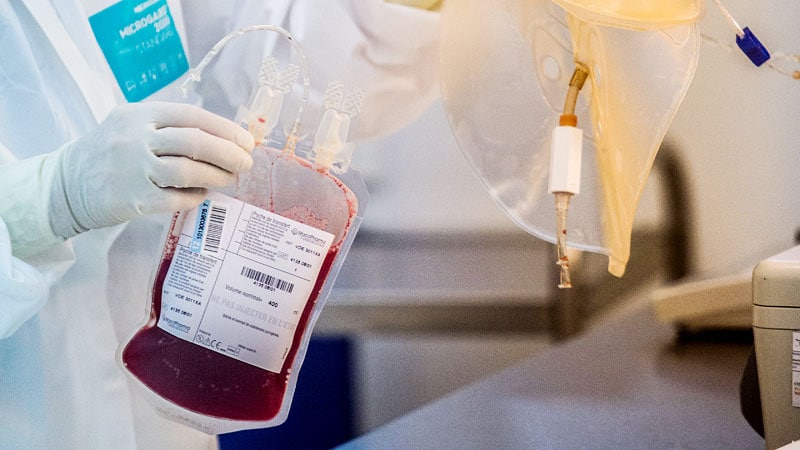TOPLINE:
A novel Comprehensive Health Assessment Risk Model (CHARM) incorporating seven health variables effectively predicts nonrelapse mortality and survival in allogeneic hematopoietic cell transplantation recipients aged at least 60 years. The model stratified 1-year nonrelapse mortality rates from 8.1% to 23.3% across risk groups, outperforming traditional assessment methods.
METHODOLOGY:
- A multicenter (n = 49), prospective, observational clinical trial enrolled 1105 recipients of allogeneic hematopoietic cell transplantation aged ≥ 60 years (range, 60-82 years) from centers across the US.
- Researchers analyzed associations between 13 measurements of older adult health and nonrelapse mortality within 1 year to construct a comprehensive health assessment risk model using multivariate Fine-Gray model and grouped penalized variable selection.
- Analysis included two machine learning models (Cox and pseudo-value boosting) for comparison, with performance evaluated using area under the curve, bootstrap and cross-validation sampling, decision curve analysis, calibration, and Brier scores.
- Primary outcome measure was 1-year nonrelapse mortality, defined as death without relapse or progression of primary hematologic malignancy.
TAKEAWAY:
- Primary-CHARM identified seven key predictors: higher comorbidity burden, C-reactive protein, weight loss, and age, along with lower albumin, patient-reported performance score, and cognitive score (hazard ratio [HR], 2.72; P < .0001).
- Patients in low, intermediate, and high CHARM score tertiles showed 1-year nonrelapse mortality rates of 8.1% (95% CI, 5.6-11.1), 12.1% (95% CI, 9.1-15.7), and 23.3% (95% CI, 19.0-27.7), respectively.
- Overall survival at 1 year was 71.7% (95% CI, 68.2-75.1), with CHARM scores stratifying survival to 81.2%, 73.8%, and 59.6% for low, intermediate, and high-risk tertiles.
- CHARM demonstrated higher net benefit than HCT-comorbidity index across a wide range of threshold probabilities for nonrelapse mortality.
IN PRACTICE:
“The CHARM should improve decision-making [and] selection of the best transplant strategy by weighing risks vs benefits, allow calibration of data across trials and institutions, and ensure that appropriate older patients are not excluded from curative-intent allo-HCT,” wrote the authors of the study.
SOURCE:
The study was led by Mohamed L. Sorror, PhD, Clinical Research Division, Fred Hutchinson Cancer Center in Seattle, Washington. It was published online in Blood Advances.
LIMITATIONS:
The researchers acknowledged that the cross-validation bias-corrected area under the curve of 0.591 for primary-CHARM was modest, indicating room for improvement in predictive accuracy. The study’s large sample size requirement and declining nonrelapse mortality made a parallel external validation cohort impractical. Additionally, the contribution from underrepresented minority groups was modest despite broad eligibility and supporting three languages. The study was conducted only in US centers, potentially limiting its global applicability.
DISCLOSURES:
The study received support from grants U10HL069294 and U24HL138660 to the Blood and Marrow Transplant Clinical Trials Network from the National Heart, Lung, and Blood Institute and the National Cancer Institute. Sorror reported receiving consultancy fees and honoraria from JAZZ Pharmaceuticals for educational talks and research funding from BlueNote. Additional disclosures are noted in the original article.
This article was created using several editorial tools, including AI, as part of the process. Human editors reviewed this content before publication.
Source link : https://www.medscape.com/viewarticle/new-tool-guides-blood-cancer-txs-patients-60-2025a1000ls5?src=rss
Author :
Publish date : 2025-08-18 12:30:00
Copyright for syndicated content belongs to the linked Source.
